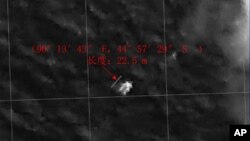Malaysia's defense minister says a Chinese satellite has spotted a large object floating in the Indian Ocean southwest of Australia where officials hope to find a Malaysia Airlines plane that has been missing for more than two weeks.
"Chinese ships have been dispatched to the area," Malaysian defense minister and acting transport minister Hishammuddin Hussein told reporters.
The object, around 22 meters long (74ft) and 13 meters (43ft) wide, was spotted early on March 18 around 120 km (75 miles) from a location where possible debris was sighted by another satellite on March 16 in the remote ocean off western Australia, China's State Administration of Science, Technology and Industry for National Defense (SASTIND) said on its website.
China said an image of the object had been captured by its high-definition earth observation satellite "Gaofen-1." The location was south by west of the possible debris announced by Australia on Thursday, SASTIND said.
However, Hishammuddin said there was still no confirmation that debris detected by a satellite in the Indian Ocean several days ago was from a missing Malaysia Airlines plane.
He said that his biggest concern was that if the debris was not found and identified, the search would have to go back to the two corridors in a "huge and massive area."
Search intensifies
Earlier Saturday, Australia dispatched search planes for a third consecutive day to search the remote southern Indian Ocean for debris possibly from the Boeing 777, now lost for two full weeks.
The international team hunting for the plane returned Saturday to an area about 2,500 kilometers southwest of Perth where an Australian satellite spotted two large objects earlier in the week.
Weather conditions were good, with 10 km (6 miles) of visibility, according to officials — a crucial boost for a search that is relying more on human eyes than the technical wizardry of the most advanced aircraft in the world.
It takes several hours for planes to reach the search area from Australia. By that time, ocean currents could have pushed the debris farther away.
Australian Deputy Prime Minister Warren Truss says the search for the missing Malaysia Airlines jet will continue indefinitely.
According to several people familiar with the matter, India has told Malaysian investigators that it had found no evidence the plane flew through its airspace, making the satellite debris lead more solid.
It was the first formal notification that India had come up empty-handed after checking its radar records, the sources said.
Hishammuddin asked the U.S. Defense Department Friday for underwater surveillance equipment to help with the search.
A Pentagon spokesman did not say what equipment the U.S. might provide, but that Secretary of Defense Chuck Hagel is considering the request and whether it would be helpful in looking for the aircraft.
The Malaysia Airlines Boeing 777 with 239 people on board disappeared two weeks ago during a flight from Kuala Lumpur to Beijing. There has been no firm evidence, so far, of what happened to the jet.
Investigators are not ruling out anything, including catastrophic mechanical failure, terrorism or pilot suicide. They say it is possible that someone with knowledge of planes diverted it far off course.
Twenty-six nations have been hunting for the plane across an area covering more than 7 million square kilometers, from Kazakhstan to the southern Indian Ocean.
Aircraft and ships have also renewed the search in the Andaman Sea between India and Thailand, going over areas in the northern corridor that have already been exhaustively swept to find some clue to unlock one of the biggest mysteries in modern aviation.
Emotional toll
The search itself has strained ties between China and Malaysia, with Beijing repeatedly leaning on the Southeast Asian nation to step up its hunt and do a better job at looking after the relatives of the Chinese passengers.
For families of the passengers, the process has proved to be an emotionally wrenching battle to elicit information.
In a statement on Saturday, relatives in Beijing lambasted a Malaysian delegation for "concealing the truth" and "making fools" out of the families after they said they left a meeting without answering all their questions.
"This kind of conduct neglects the lives of all the passengers, shows contempt for all their families, and even more, tramples on the dignity of Chinese people and the Chinese government," they said.
Some experts have argued that the reluctance to share sensitive radar data and capabilities in a region fraught with suspicion amid China's military rise and territorial disputes may have hampered the search.
Additional information for this report was provided by Reuters.
"Chinese ships have been dispatched to the area," Malaysian defense minister and acting transport minister Hishammuddin Hussein told reporters.
The object, around 22 meters long (74ft) and 13 meters (43ft) wide, was spotted early on March 18 around 120 km (75 miles) from a location where possible debris was sighted by another satellite on March 16 in the remote ocean off western Australia, China's State Administration of Science, Technology and Industry for National Defense (SASTIND) said on its website.
China said an image of the object had been captured by its high-definition earth observation satellite "Gaofen-1." The location was south by west of the possible debris announced by Australia on Thursday, SASTIND said.
However, Hishammuddin said there was still no confirmation that debris detected by a satellite in the Indian Ocean several days ago was from a missing Malaysia Airlines plane.
He said that his biggest concern was that if the debris was not found and identified, the search would have to go back to the two corridors in a "huge and massive area."
Search intensifies
Earlier Saturday, Australia dispatched search planes for a third consecutive day to search the remote southern Indian Ocean for debris possibly from the Boeing 777, now lost for two full weeks.
The international team hunting for the plane returned Saturday to an area about 2,500 kilometers southwest of Perth where an Australian satellite spotted two large objects earlier in the week.
Weather conditions were good, with 10 km (6 miles) of visibility, according to officials — a crucial boost for a search that is relying more on human eyes than the technical wizardry of the most advanced aircraft in the world.
It takes several hours for planes to reach the search area from Australia. By that time, ocean currents could have pushed the debris farther away.
Australian Deputy Prime Minister Warren Truss says the search for the missing Malaysia Airlines jet will continue indefinitely.
According to several people familiar with the matter, India has told Malaysian investigators that it had found no evidence the plane flew through its airspace, making the satellite debris lead more solid.
It was the first formal notification that India had come up empty-handed after checking its radar records, the sources said.
Hishammuddin asked the U.S. Defense Department Friday for underwater surveillance equipment to help with the search.
A Pentagon spokesman did not say what equipment the U.S. might provide, but that Secretary of Defense Chuck Hagel is considering the request and whether it would be helpful in looking for the aircraft.
The Malaysia Airlines Boeing 777 with 239 people on board disappeared two weeks ago during a flight from Kuala Lumpur to Beijing. There has been no firm evidence, so far, of what happened to the jet.
Investigators are not ruling out anything, including catastrophic mechanical failure, terrorism or pilot suicide. They say it is possible that someone with knowledge of planes diverted it far off course.
Twenty-six nations have been hunting for the plane across an area covering more than 7 million square kilometers, from Kazakhstan to the southern Indian Ocean.
Aircraft and ships have also renewed the search in the Andaman Sea between India and Thailand, going over areas in the northern corridor that have already been exhaustively swept to find some clue to unlock one of the biggest mysteries in modern aviation.
Emotional toll
The search itself has strained ties between China and Malaysia, with Beijing repeatedly leaning on the Southeast Asian nation to step up its hunt and do a better job at looking after the relatives of the Chinese passengers.
For families of the passengers, the process has proved to be an emotionally wrenching battle to elicit information.
In a statement on Saturday, relatives in Beijing lambasted a Malaysian delegation for "concealing the truth" and "making fools" out of the families after they said they left a meeting without answering all their questions.
"This kind of conduct neglects the lives of all the passengers, shows contempt for all their families, and even more, tramples on the dignity of Chinese people and the Chinese government," they said.
Some experts have argued that the reluctance to share sensitive radar data and capabilities in a region fraught with suspicion amid China's military rise and territorial disputes may have hampered the search.
Additional information for this report was provided by Reuters.














